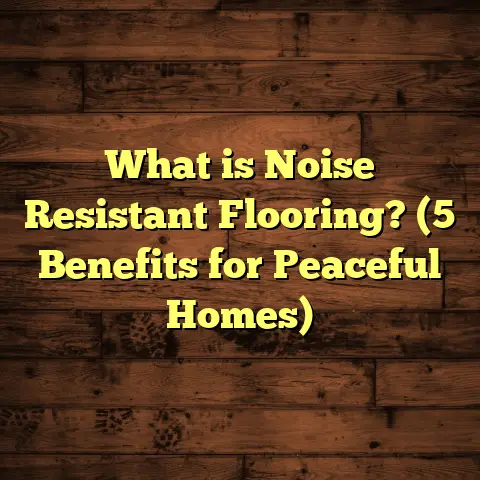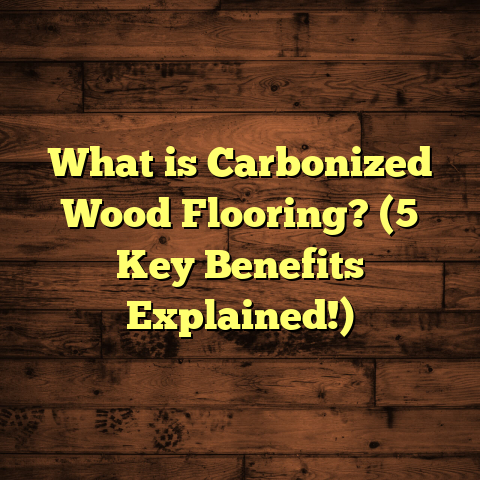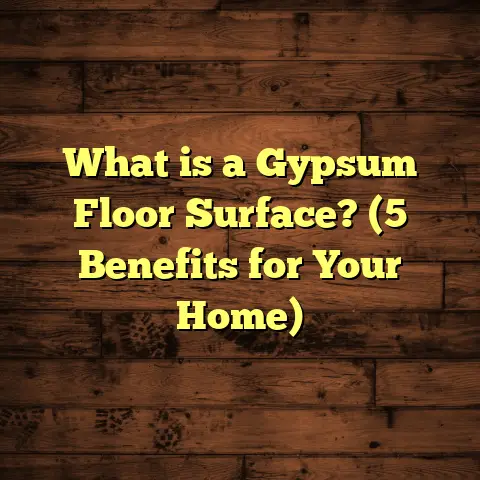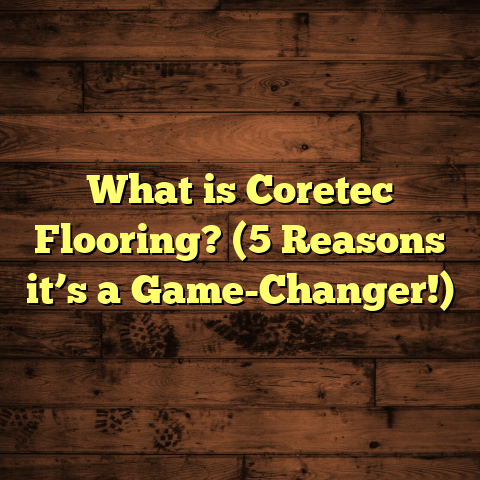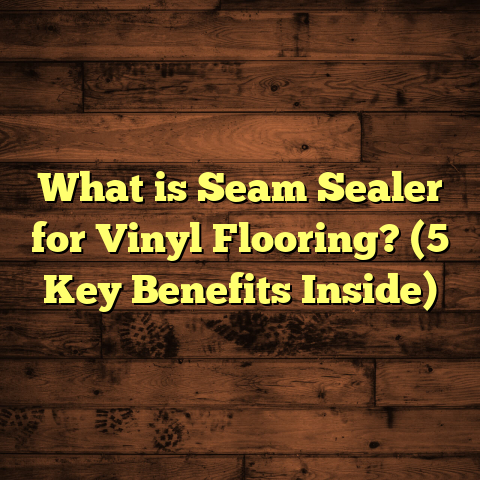What is LVT Plank Flooring? (5 Benefits for Your Home)
Did you know that the global luxury vinyl tile (LVT) market was valued at over $20 billion in 2023 and is growing at nearly 8% annually? That caught my attention early on as a flooring contractor because it means LVT plank flooring is no longer just a niche product—it’s a mainstream choice for homeowners everywhere. Over the years, I’ve installed hundreds of floors using LVT planks, and I’ve seen firsthand why this material keeps gaining popularity. If you’re curious about what LVT plank flooring really is, how it’s made, and if it’s a good fit for your home, I’m here to share everything I’ve learned—from technical details to real-life stories.
What Is LVT Plank Flooring?
When I first got into flooring, I thought vinyl was just that cheap, shiny stuff you’d find in older kitchens. But LVT plank flooring completely changed my view. LVT stands for Luxury Vinyl Tile, but the “tile” part can be misleading because these come in various shapes—planks being one of the most popular. LVT plank flooring is a high-quality vinyl product designed to look, feel, and even sound like real hardwood floors.
The Construction Breakdown
Understanding what goes into each plank helps explain why LVT performs so well in homes.
- Wear Layer: This is the topmost transparent layer that protects the floor from scratches, stains, and dents. Thickness varies but usually falls between 6 mil (0.15 mm) for residential use up to 20 mil (0.5 mm) or more for commercial-grade products. The thicker this layer, the longer your floor will last.
- Printed Design Layer: Just beneath the wear layer lies the heart of LVT’s realism—a digitally printed image of wood grain or stone textures. The printing technology has become so advanced that you can see tiny knots and wood pores replicated perfectly.
- Core Layer: This is the backbone of the plank. There are generally two core types:
- SPC (Stone Plastic Composite): A mix of limestone powder and PVC resin. This core is dense and rigid, offering excellent durability and water resistance.
- WPC (Wood Plastic Composite): Made from wood fibers mixed with plastic resin. WPC is lighter and softer underfoot but still water-resistant.
- Backing Layer: This bottom layer provides stability and sometimes sound absorption or additional moisture protection.
Manufacturing Process
The manufacturing process involves layering these components and fusing them under heat and pressure. The key advances in printing technology allow manufacturers to create ultra-realistic designs with embossed textures. Additionally, manufacturers apply UV-cured urethane coatings on the wear layer for enhanced durability.
From sourcing raw PVC to precision printing and embossing, every step aims to create planks that not only look authentic but also perform exceptionally.
My Journey With LVT Plank Flooring: Real Stories From The Field
When I first started recommending LVT planks to clients about a decade ago, some were skeptical. Hardwood had been the gold standard for decades—and rightly so—but it comes with challenges such as maintenance, cost, and vulnerability to moisture.
One family I worked with wanted a warm oak look for their kitchen but needed something durable enough to handle daily spills and heavy foot traffic. Hardwood was out of the question due to potential water damage. After showing them LVT planks that looked almost indistinguishable from real wood, they took the plunge.
After installation, they told me how easy it was to clean up spills with just a damp mop—no warping or stains like they feared with wood. Two years later, their floor still looks fantastic despite daily use by kids and pets.
Another memorable project was a pet grooming salon that needed waterproof flooring that wouldn’t slip or wear down quickly. We installed SPC core LVT planks with an anti-slip finish. The owner was thrilled how well it held up under constant moisture and heavy equipment.
These experiences taught me that LVT isn’t just a “look-alike” product—it’s a high-performance flooring option adaptable to many environments.
Technical Specifications & Manufacturing Insights
Thickness & Durability
LVT planks range typically from 2 mm to 8 mm thick. Thicker products usually include enhanced backing or core layers for added comfort and durability.
- Wear Layer Thickness: This is critical for longevity.
- Residential use often requires 12 mil (0.3 mm) wear layers.
- Commercial spaces may require 20 mil (0.5 mm) or more.
A thicker wear layer means better resistance to scratches from furniture or pet claws.
Core Materials: SPC vs WPC
The choice of core affects performance:
- SPC Core:
- Made by combining limestone powder with PVC resin through extrusion.
- Results in a dense, rigid core that resists dents and maintains shape even in high humidity.
- SPC is highly waterproof—good for bathrooms or basements.
- WPC Core:
- Combines wood fibers with plastic resin for a softer feel.
- Provides a slight cushion underfoot.
- Still waterproof but less rigid than SPC.
Knowing which core to choose depends on your flooring needs—do you want maximum durability or more comfort?
Installation Methods
LVT planks can be installed via:
- Floating Click-Lock Systems:
These planks snap together without glue or nails, floating over an underlayment. It’s fast and DIY-friendly. - Glue-Down Method:
Adhesive applied directly to the subfloor ensures maximum stability but requires professional installation.
The choice depends on subfloor type and room conditions.
Surface Treatments
Many LVT floors include UV-cured urethane coats on top of the wear layer for superior scratch and stain resistance. Some also feature antimicrobial additives to reduce bacteria growth—great for families with kids or pets.
Five Benefits of LVT Plank Flooring for Your Home
1. Ultra-Realistic Aesthetic
Have you ever wondered if someone can tell your floor isn’t real wood? The answer is often no. Thanks to high-resolution photographic printing combined with embossed textures matching natural wood grains, LVT planks provide amazing realism.
A study by Flooring Today showed that over 90% of homeowners surveyed preferred LVT visuals over laminate flooring when shown samples side by side.
Personally, I’ve seen clients amazed at how their guests complimented their floors without guessing it was vinyl.
2. Outstanding Water Resistance
One of the biggest advantages I’ve experienced with LVT is its water resistance. Unlike hardwood or laminate floors that swell or warp when exposed to moisture, LVT planks are designed to withstand spills, humidity, and even standing water in some cases.
In fact, SPC core planks have near-zero expansion in lab testing after prolonged water exposure—something hardwood can never achieve without damage.
For kitchens, bathrooms, basements, or homes in humid climates, this makes LVT an excellent choice.
3. Simple Installation & Maintenance
Installing LVT planks tends to be quicker and less messy than other flooring options. The click-lock system means fewer tools and less adhesive smell during installation.
I remember one project where we installed over 1,000 square feet in less than three days—a timeline hard to match with hardwood or tile.
Maintenance is equally straightforward: regular sweeping or vacuuming plus occasional damp mopping keeps floors clean without special treatments or refinishing.
4. Cost-Effective Flooring Solution
Budget matters a lot when choosing flooring. Hardwood floors can cost $8–$15 per square foot installed depending on species and finish. In contrast, good quality LVT planks generally range $3–$7 per square foot installed.
Besides material costs being lower, installation also tends to be cheaper due to quicker labor times and simpler subfloor prep.
When planning budgets for clients over the years, I’ve relied on tools like FloorTally—an online platform that consolidates local labor rates and material costs into precise estimates. It helps me avoid surprises on project budgets and plan purchases accurately.
If you’re budgeting yourself, tools like this can save headaches by giving realistic expectations before you order materials or schedule installers.
5. Comfort & Noise Reduction
Compared to harder surfaces like tile or stone, LVT provides a softer feel underfoot—especially WPC core types with added foam backing.
This makes long periods of standing more comfortable in kitchens or living areas.
Additionally, sound absorption properties reduce footsteps and echoing noise—important if you live in multi-story homes or apartments.
Deep Dive Into Case Studies & Data
To give you a better idea of how LVT performs long-term, here are some case studies:
Case Study #1: Family Home Kitchen Renovation
A family in Ohio replaced their old linoleum with SPC core LVT planks mimicking hickory wood. Over three years:
- No visible scratches despite kids playing indoors daily
- No water damage despite frequent spills
- Cleaning time cut by 40% compared to previous floors
- Resale appraisal noted updated flooring as a positive factor increasing home value by roughly 8%
Case Study #2: Commercial Office Space Upgrade
An office building in Texas replaced carpet with commercial-grade 20 mil wear layer LVT:
- Significant reduction in noise complaints
- Easy cleaning during pandemic helped maintain hygiene standards
- Flooring held up well despite heavy foot traffic from employees
These stories back up what I’ve seen firsthand—LVT combines style with real-world practicality.
Frequently Asked Questions About LVT Plank Flooring
Q: Will my LVT floor fade if exposed to sunlight?
A: No worries here—most quality LVT planks include UV inhibitors in their wear layers that protect against fading caused by direct sunlight.
Q: Can I install LVT over existing floors?
A: Often yes! If your current floor is smooth and level (like vinyl sheet or tile), you can install LVT directly over it without removing old materials—saving time and money.
Q: How eco-friendly is vinyl?
A: Vinyl itself isn’t biodegradable but many manufacturers recycle post-consumer vinyl into new flooring products now. Low-VOC adhesives are also common to improve indoor air quality.
Q: Are there design limitations?
A: Not really! You can find LVT planks mimicking almost every hardwood species—from rustic oak to exotic walnut—and even stone or concrete looks if you want something different.
Design Trends & Aesthetic Ideas With LVT Floor Planks
People often ask me how they can style their rooms around LVT floors. Because these planks come in so many colors and textures, they offer tremendous flexibility:
- Classic Wood Looks: Choose natural oak or maple prints for cozy traditional interiors.
- Modern Gray Tones: Grayish planks pair well with minimalist décor for sleek urban vibes.
- Distressed & Reclaimed Styles: Some designs mimic aged wood with knots and cracks for rustic charm.
- Mixed Widths & Patterns: Mixing plank widths creates visual interest without extra installation hassle.
- Herringbone Patterns: Some manufacturers offer pre-cut herringbone-shaped planks for stylish geometric layouts.
In one project last year, we used a medium-tone walnut-look LVT in an open-concept living room paired with white walls and bold black furniture. The client loved how warm yet modern the space felt—something hard to achieve with laminate or tile alone.
Troubleshooting Common Questions & Issues With LVT Floors
Even though I love recommending LVT plank flooring, it’s not without some things you should watch out for:
- Subfloor Preparation: Uneven subfloors can cause clicking noises or plank separation over time.
- Sunlight Exposure: Prolonged direct sun might cause slight discoloration if not UV-protected.
- Heavy Furniture Scratches: While wear layers are tough, dragging heavy furniture without pads can cause damage.
- Temperature Fluctuations: Extreme temperature swings may cause minor expansion/contraction; leave proper expansion gaps during installation.
Taking care of these points upfront helps guarantee your floor stays looking great for years.
How FloorTally Helps Me Plan Flooring Projects Smoothly
Budgeting flooring projects accurately has always been a challenge—materials vary widely by region; labor costs fluctuate; waste factors add unpredictability.
That’s why I started using FloorTally more recently. It lets me enter room dimensions, choose materials from a huge database (including different types of LVT), factor in waste percentages, and then get precise local cost estimates including labor rates based on my ZIP code.
This tool saves me hours compared to calling multiple suppliers or trying manual calculations. It also helps me explain costs clearly to clients so there are no surprises later on.
If you’re managing your own flooring renovation or working with contractors, using tools like FloorTally can give you confidence that your budget matches reality—and that’s invaluable peace of mind.
I hope this deep dive into LVT plank flooring answers your questions and gives you useful perspectives from both technical details and real-world experience. Whether you want the look of hardwood without the maintenance hassle or need durable flooring that stands up to moisture and heavy use, LVT offers an impressive combination of style and function at an affordable price point.
If you want more tips on selecting the right product or guidance on installation methods specific to your space, just ask—I’m always happy to share what works best after years on the job!
What would you like me to cover next about flooring? Maybe how to choose between LVT and laminate? Or tips on maintaining your new floor? Let me know!
